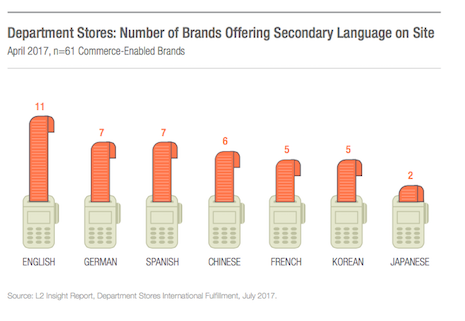With the growing demand for international commerce, it is more important than ever that brands are able to fulfill international transactions, but certain elements such as choosing a preferred currency or language are often lacking.
In a new report from L2, "International Fulfillment: Digital Experiences for Cross-Border and Tourist Consumers," the market researcher took a look at the ways brands and retailers offer and fulfill international commerce. L2 found that while 45 percent of customers would prefer to be able to choose their currency on checkout, only 15 percent of global brands allow that option.
Cross-border commerce
International commerce has been growing in recent years. This is especially true for luxury, which regularly sees customers buying goods from both established and developing markets.
In this climate, it is important for brands to be able to provide international customers with the best experience possible to facilitate more transactions.
One way of doing this is by letting customers choose their desired currency or language. Unfortunately, only 15 percent of brands allow this, according to L2.
The majority of retailers do not provide specific information on their Web sites for international shoppers, which would help them navigate the intricacies of buying and shipping international goods online. Only 9 percent of retailers surveyed by L2 have Web pages set up for this purpose.

Department stores offering international shipping. Image credit: L2
L2 notes that all-digital retailers such as ASOS or Farfetch are much better about building a global audience with an international focus than heritage brands, which tend to focus more on their home countries and near neighbors than on the entire world.
But those heritage brands can fix some of their mistakes in fairly simple ways. L2 suggests creating new content and translating what has already been produced on their Web sites specifically addressed to international buyers.
Cross-border commerce is expected to bring in $424 billion in the next five years and make up 15 percent of the global ecommerce market. If brands want to take advantage of this, they have to get the details right as soon as possible.
Localized content
Successful international ecommerce strategies go beyond translating a Web site into consumers’ local languages, according to a previous report from L2.
Cross-border ecommerce opens up brands to shoppers in countries that are growing more rapidly than established, saturated markets such as the United States and Europe, but retailers should do their due diligence before making a move. To make headway with global consumers, localization efforts should deliver both market-specific content and commerce features (see story).
Luxury is one of the top three sectors for international ecommerce, and that share is likely to swell as desire for cross-border luxury goods grows.

Brands offering language options. Image credit: L2
As more brands offer options for international shipping and local currency purchasing, luxury consumers are beginning to expect a certain level of convenience to cross-border ecommerce. The luxury brands that encourage this expectation and rise to meet it will be most successful (see story).
Tapping into the desire for international ecommerce will require luxury brands and retailers to put in the work necessary to make their digital platforms completely country-agnostic. Doing so will ensure that customers from any corner of the world can easily place orders in their preferred language with their preferred currency.
Making that happen will be key to success.
{"ct":"qoUXAfQTyBECEl7gMzo9agDtbxLXKZudMIc3csVoWYsdfxDESDNHWtEIba6ELM5Cz38CDXHtHjCNxl5Kku\/5AmUGjSEW4oh2tia1Ao3Bgpuepm+5wG5tzSdCFiTIXj1VmtDt3xQJo4xBRvA2PBwSHJ7AqdFhocn5pJukuiKZOq5YIntniSGdk+YFlLJHJAyCxyhKAorFn4bLo79bRJrdJazuXRVHNWzvD2HpdP5wb4MyzHtIEG6XNvLih7rtQNiKIAusYMYNJ84JkuHd3VDeDhPR5h0ksCd8cK4T7EPUnQ\/3fuCHf0Z18oBTi6FWwAI63O13cboyBjXs6628tPNe4tmoreDmDHzr\/dKqlC9wHbiH4+Qo4ss\/+KvH0CU5NcHvr9BbNkumLm9nRayceKru7Lm+pN+0QH+vxcbPNKYxTR+e6GaCXGN6PSEzqiCMA2pw6qdt7F0Ahua\/Kf0POyyjyE1irHeDQwls83eukOqM6E4XC+1xgab7iEaU+tPIWUCARkuJtpHraT6eVPzGe217LOP7kL0aW68whsCAzQAJF8vhFRPjCkoIUX2khFfPp9T8yUz4Mep1DZrUkuX09VTC9js7n\/nzO6ecPEj+st3zi7SyCnZajNgEjUkrtBMeZqg5EvEyPbdZXEVg9hprInZrQeeLEt+K2HsUlNezncv\/l2r2ZP87VIR1eYF0\/YfDINqJZTj5xeoD7WPw9FMNXtpZDc04uB+h3KOmIIUal\/m60KuQT9oEsxmc9T+hpsZepKqGE9zqRKnq7lQirQ23EZkAk4W3+hutgg0mfZfQjyh3SVRwsyjMIOspn0PpoqSg46EmZ0AkrZUe+yoRsV7sxSthReQOomZDO8r7XP3VIqmIhfcm5DKZiSNyONwydXOsti5Y6LUUgiK09J++6r+QR8baRtYVwDIauBEMdaXnmrxUdljc6IY1Tvu3j3PGwXcE3uHneQjjnkx51HQY26eLZo5WWP9rGoerhggesNkDz1Ht\/VI8\/kavSSSIeivx7urvrCV+712OIml8mnyvqBHkTg2nKwbdUqQthfQ\/IqbIDf0fRgpgPao7QGKo4jIkpj3wMTO6+LdoCycecha0tsUP3dMVtHkiummm+ehhsnwrlV3mJKGU8rxRXy723xLITLYUvKS1JrdbdbN5vgOytP6S3i8W\/fi+sfGmTLpVDYGp64C57hDg6s9O326VJXaqq9JiARgalaVYihC5bBXQoO\/T5jNs1BNpSycFW856Xc04Z\/qxmiLR3foZHy5eemFpPwf9nnJYpICDll+MR7fzin9zYG\/\/1NswHsE4Nlk0naH5g+XG32er0RfVUinr+qyHNjDgnnSHafaGwBIhmU\/J2Mcb2LUVFbPDvNSYwVg6tr3ccLNI0QZWSoWeko7dohUqi8i2eC9sFQVIElFosbqbnSSO9DNRV3lOh\/osZfZlqYskP0jh1OqmMJO0xNzVguIAEzxtSVNll+oJ+xa1lzi2K3HfCNzv2ZPY0HI\/0F4TTl2V0L5VBZTNRqd9pRQZmlaXihMoXFVD7K1FdGCBFjkQ6iU2XWg4NbVXFeYcg38zHQMdculti97t7tXlo3Gk1OFUccsGZBnL1CI\/X+gNhSJboTpWFRRVMc5lu6KZQfCyTcwJUCyKenqv34zCxDYvaGYoAEfrpDHXFhDYmCNhnb0ShVmd\/Yb67LMNVd1kL9E\/DlTTIvLj5TFr0yzCDoIpt0OBgTae2T\/S\/IyXUU3hICxwL6VyWsQcpmpNT\/\/U1UrqjF2gU+whSLXw3BkPGUe+KSx4ITgLEd57CImod5wWhG+iV5X4\/ZTMvqjeTnZn3sJmyTiPhoGuaz90XmDlLU2QAlYextLwEQEAMBpyNB7BHWullNO2oj5HdcXCfrb8UwPW95q2JJda2UmBcwCnkwkH6qmcjfQugeOXzi9o87aeNaPFbWsx4PlBaniK90mWm0M89kikZWP4qDnGT1sKBvXNdnVNXGTvz4hDZFkKuNxdIXsdK5pP1Uaw1oMUjzl4Adp0D3\/h5Az59JeAyjI+Jhxryyt7AgPzKZV0LOlNMIx9DVul3U8YIXGkOctQDhkcHtnS0cPQt0bEQfVRPRNsgKHallI9YudiWieaIjZdLA1aMaNrkz0J7pHKNUprr08NT5k5kjUk\/DAQHPWXsnlQxD4sBOSbg3MUtvGjjrNYQ+WwH3XFMI5+JpaXt5nyRiOo+t+mTZMcZ80Opm5VFdDX5gW5H6yvYpUevl6mOD+zwkRrRqOEPeZ24jeTYv\/af2hDVIneyY9o4O9rbuxgcYIJOPEH8OvbW6w7Ecvmp1cdwz8+vyflTQcM77g8R+mh4UETo\/hfb\/okk\/5cRZC+fZ+9pmzgjPT9rvH8C6hcpRmo2VMk7R6pqZ3ckjAaare47egnAVGZRrXOpaNUPkTlkRIG8Y7r1xBkq0JEd4GuwPw+LABa4Os2bAX+LqJDnzfq7t0bw1b1D\/wWR+05JjWooYWey77q6xHJLG5aSS7Iy2ecElc9e7Q6mimMNnVmcvUqLRSTSE1h8ZU1cYBcHPdEB8RiWAYn1062nRAcmVovvdSN124e26zG+Pt4hTRVaQiO1jkqrz2G73QAFj21q8an8vBAs\/vvt9jd\/dAnG6fiYNk2Dm3\/xVjoNzl\/6QWuka\/hkbQ0tUWqWbqqOryAlt\/XXDDW68xbiNvljEOxow\/S68WxpN3n3reQ68FZqQWrs+l7ToE0ZBEkWPHJKP+LYp34nM+YTX3iCgy9Sc1N4VV\/4XQjIHkCXHq2f0a+ZziOGzm6ubWFRxkNyudA4GsU5YgLJF7SSZRcKWQK5jCZeL5GYAqZeSqF+ahw\/rp1KhULok908kU+8fIpkMlpARW5VcSKEhb0gUq7\/OydtsLufSxHcjcHhroI5uk415MnMh5p4is1N\/7sQJWUxV8atIBpU+Es\/gP\/eCwzOtlH0phZhLHO5AbKj9MiKBCxMBTL3I\/9woZyWeXGjQl7rvYV9d4ot5in1pcc3h0NboU4R\/f7NpYj37Wdud+RONh7aLToRFbA0mNN9Lwj2kSkclFl745vQDyZKM8+3LBQhqH9EgbKWMcUfSjqrwIn\/2aEq\/HcnKB4NB5qXw\/QEFA0e8WRrvhNCq2jWvy63SXGNGzAhA+K+yM5YVLnmHv686VaLYCrx2kJ4lEEQ0CW7bYWD4ngWB9KpLSfzn2ScxYt4IWUH7wcyq879OwLVF0Gi5WacoUTp84HHjqzemLutRIk8AXL8RaeQSOkvZ+bJIlb\/B87KK\/Kyt4uZbR\/yj+CIBXqHTvvfHdXzwXjsBi0Pfn05H87ApbuCw\/gykgmFKxxM2Grw4LwtiHbNfbc3lb1\/MQ2e3JT+2FaPcs3JkXd60qbvfWjBqgObuv1GLn1GLgbTm\/X2N3nJhdrW5gG3CRiDSSEuD5V3AL0t0XR8vmZRERMV1LLDcb5MrucENxLdrOIO8vFZYwW4jBDsBTZIrTh\/Dg+hkVQL7XJWjYftjncRJk5cKiWukolWUJDeGn4SB\/glMNgXb0s5Jlar5kzdXOIAn2IOzBgetdphvXzUSpH+EOplMxR2Q\/\/EMqT8JeWe1FrIv7sqox5rJw+fnfcF5erYSlj655++txolu70Kt0MMKclD46ZEBr2pwhy9xtVxxrBDZWwMa6ag7HwlJjEvL8QDT0zZWnpNC9asFCEHrkXjhkeWwadGrxXVw\/lWUhVmvmvbbaf5TG8fbyRHvm928NZrtzmQBwCKsALZlb2fPOkMDl+ztOsNJCHU60N6UEq4j+JdNOyquqjwInodVxYwU+4JtbvTEqD6fOlUUBJ+uYFLtL3lLMtXtFzUygRKq4g7PxAe7+YxSdVl++bs0iTxMyJcJK7dpf1JAjoyLJLJXFJiQCZyU7zfN\/wzFzw\/Fgk18Wof5qhFY\/j3gaPWZyY+iFFv\/vO+bjmgYQ7cjo5WdFsIOyS4bn24QHCM2r+7BlL176CMulo5TMibYERwuGBl59BgC3aToZLc27PE7mxWW\/AmSg6b7mpMievUVAHL+Ktg5Jw2CaIWwK0GtH7SCfFxTcAuoLwHCdiZYIU2+Z3Q9Cj2GJCoXHd4y9BIQa9NsU7XoNgW4KjG6KzR6joxZ42aVEpB4pvq+nLZlrNWJVG8YOmD1MSNAXTv2ANLtxYHk0FCC0vovKxuK2tOUAsgp0+B0m30JT3IJRhAGFrwgS+TAnNqnE6O8KF42LHojfpuiSAW53h4aKsyl8m4w+swiFabE5UvgdRr\/JXST5rYHnXel8a2CfC3vqfpYm09xiOUvO3\/ecX1e37CUOoQ1pAXxyonPuIyiOL1h+LyC4Q0IiM\/JcNrPX1ZtXZO9WfPKbPhvEU0QiLIhIYxSvqi9bPFSq66s4vRVjqhlxV0lcEUDBCmz020aQasIau33\/93xvT8+a+Tbf5\/tQ+OqBXlA7OupL6FNydqMmC5f4mmPU6dHRtH23odLP9lobFXmOf4Y6hMIFTt3o76PeMUseg8NwofsokFDdXC1sf+wMu2AYQTMyE7jTJPJ\/mXKft4Ml\/YvpZMOnB9v7UKQNM+4gK6Wn01tu9Zherzgj3u\/EpVPZSPOuWgxLUvgC0ZvK\/S4aWpGIxlQ2XQTi0AjF5y\/oFTXBTSd+9qtwhNko5IPaZRbn3BQjob6idgL1VVodJ3hlMKlEu+Dnl7toLYqv2IIgtLPEZr3hYpRlyS1H9P7MrQma\/9uwD6TBe\/oRxTPvs9fr53Rnu+mCHFtBoEZkQGfl4AUh0fhk0RC1XkVdymezcwnrVGkx5BfNgWzX1ujGqKV\/hZ11safRN6uhl413z3NwvhBeaLw9KmtuyfO\/6N3q5wrfgH01tjrOGlDjMxPDn9oN1brbLnOyxwxfRMBrXhlobhVNZnwACj\/lzQGKIvkUkNfw5Z5tOM3lWB7fwuml+J1SJ9SNCtkRSuGZpS8s8lDZvA5tT7Eks58FdDqhYz0GrLfHCgsUo4wFWpKPYjwaMM77fE13cADODMKVKKJOvigrp8roiiI3AirzAt8rEpStHOiYWQmfRKKeBF8tDRaz5cOtGTtbp1taf2xMyTRSl8fJchc9iC+Bcea6enRV8aOLmt+VdOTQr9\/t6ECSMmQD7GakqM5Il99CuCnsnBVXdSnWMG4sEwUElaKcxh7OL1PjGWnBbKuk8maeaIQh+Hk0AQI8AqNablwvofNnPBsks6\/\/6wxh0Dvp99AI0tLLEYwHU7NePAMUQHDJbwlUPCbG\/z7rfhvGfvLf+rnkE8zdI+kKz4TvwezRdp1rEOMHQnAPlYxEgtfwCbOdDmvgJBu+91XLYBkmfy3nqMk0ctpVakKMGXV2lNlWoCmQiYubuwZQguEjGJC5M+\/hRMabTGIzM9dNxjtQO+SH3yTNbB0lUZH\/W0loe\/rF4g1u7nABWhxCvaIgIlgk\/8rA5KpklnsaHd8Nz6MkyuEGoihRGDfWyUUPG1wU6PrTXLNvCzaeYPoVwPY6RwYZVY+KblX8rmLKGtlGJ+Dy7mzTE0eGWE4odg1\/HPTGQBWw40SGX4fKlhw90fDlWjtJ4KzeOo2w67J00BVDYH5wWVHRNinVhTuv5ewO8E7ZW\/iLRR9DMVlZL\/V3qjBI3dpdPT9vqc46e3gydUiJOPqgX11bFA2e9h31FCtEhf1Icpwd6CjB\/IDwz3W5VwIn8RjpxQFk\/w3Ire1kPBZ1JkDcgnA7lJrg+j8Do7e4JJwbjmzeo2GTkXdiKL2C7AxmPsmnlO3FmZADh9z8DTcyAdLXd8w7aII0v+LIRkYyZ9u76lWOYVYb2hFvTVbBkR7V0ZC0jI2K2ItNfARLBpWs7pmq0RFo0mcZYnX2Eab0oAkM+Bq\/de6AsqC+Yg6PZsKTmOlpxzc2pOiksP3wgqomQMKlEzu0kEB2T1YrHt2t56zViAP5H08rz1Br1mcjPofo+H02NElv+4YEacdflDj2gUyTzS88M2\/NK6WF2vwDu00JjFqHvyRFMUOadkWiT3cSq6bZjouMVrKYDpma6pA324dhTl99qZc6hgYGhlR4fMnlVfhlxJccmTk0fVYeQH+8C0zuR4LrgPnSTBaqJpPm2eIbKPWz\/UfvLGH+XQfp4DkW8FRZHzoaEeyp9j1Md34UdzgCxue+yY34XQ5KRVlLJo7547+s81+a74dxkvwjg\/QHieWHs+y2KK81tkhYbogMopMAMO8EwJavVQndlYAPuWykYpAlgB92eIJUYOntAFfBk2pMeZxf04D\/09\/UVUDjswHM1akldaYOL7F0OK4BZ9lp7XYCVl7e3VZcl6UNfPAtv1UD54pbjAo9y3XCrOY67ZMiwrHPw\/F8OMNR4LJno2n8VeCZw+C7yh56HUdF0Cuz\/HZZUoMZA1MiKTt0t\/zIlcMlBwUubHxLGlAeu1Vg9KRTkPM8KftK\/r+kPoeg22oftAUIiAoIY6s28t9VLAiHNAiRzRUCSXWhpRO+hFRzOI1pNhRmyKj1ElpDQrluXZQsvpjSZ8B3h06HAuj7IOcGai7bsHsNiM1UkwgowDl1ivQbVaS1aS5uyPfHb71VyxTdhNPeMSJEytAs+dH+lyDy86+4J1Z4PHQXhUOcrBPCFqj5zw3HyzJfA+lqiKR3YIhLVhOaPj\/1YlkX78SfBabJCtrskHoQQEdjOeqhb9JJoEpx1z+rWopopYIejSBBpDZwlCud60QuYKwF6\/us+69jW1jCGxUCwzPgpd2SxpPzZhXYbfrvSxUxB\/BX8+jjDiJKZ6kLybnNbiU3rhd8iAhxM\/w==","iv":"5d06fca6ccafd0e7ca2c878b11117e0c","s":"7d99afe9dd19f631"}

 L2 emphasized more options for international buyers as key to retail success. Image credit: Piaget
L2 emphasized more options for international buyers as key to retail success. Image credit: Piaget